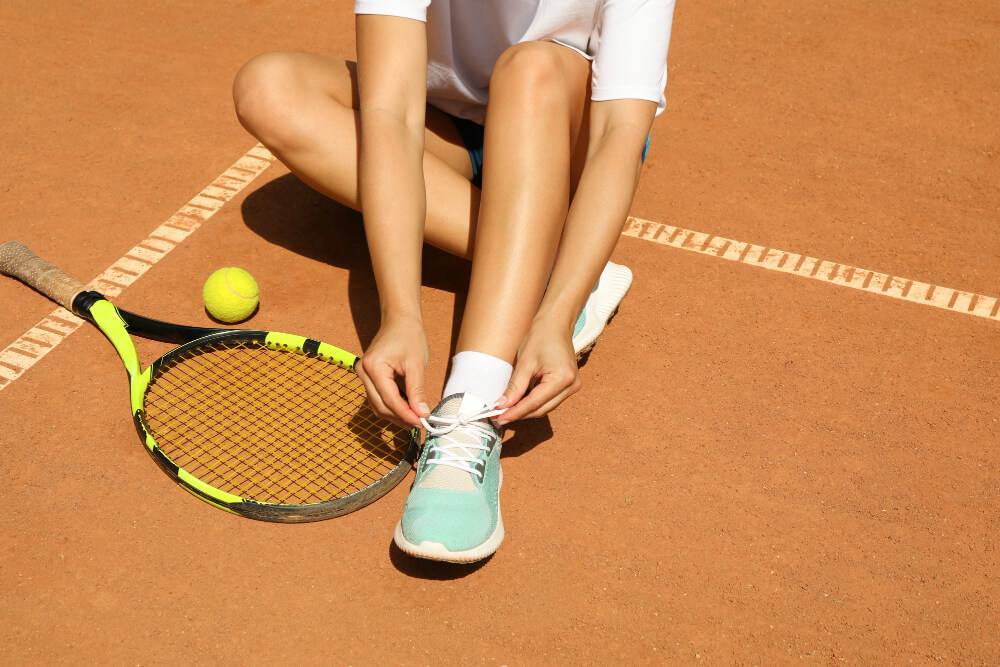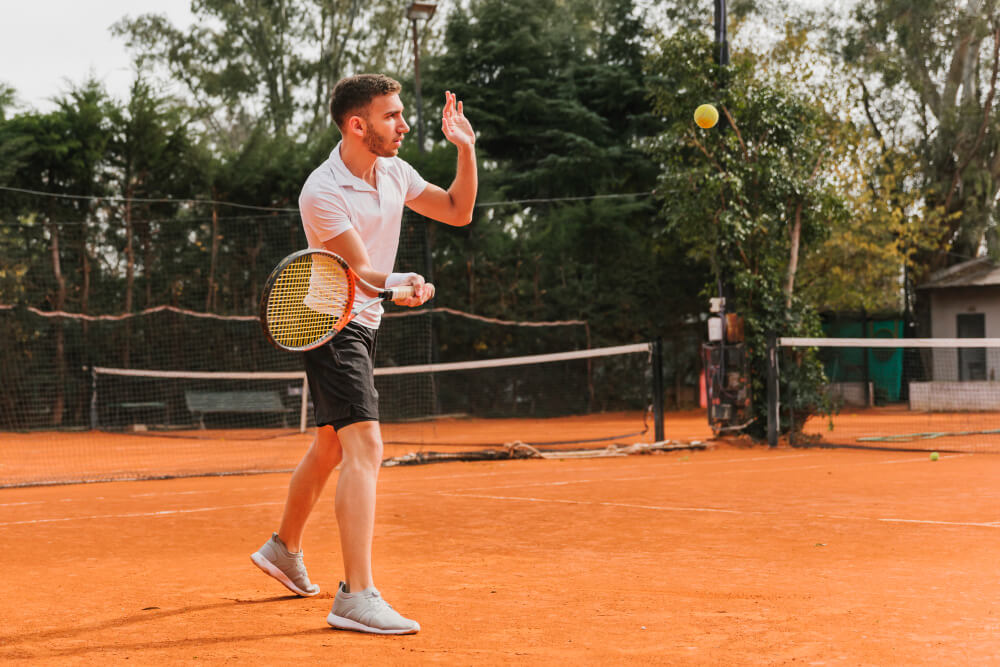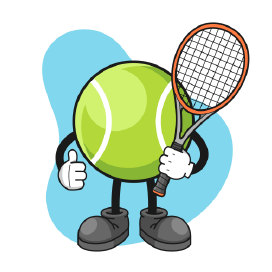When it comes to choosing the best tennis racket, there are many factors to consider. Every player has different needs, and understanding which racket best suits your style of play is essential. Factors such as racket size, weight, balance, string tension, head size, and material all play an important role in finding the best weapon for you on the court.
Racket size
Racket size ranges from extra-long sizes (27+ inches) to junior sizes (19-21 inches). Most players should opt for a standard length (around 27 inches) as this offers a good balance between speed and power.
However, if you’re a tall player then going with a longer size may be beneficial for generating more power on your shots. Shorter players can go with smaller sizes that will provide better control when playing.
Racket weight
The weight of the racket is also essential. The lighter the importance of the racket, the more control you will have on each shot. However, if you don’t generate enough power yourself then going for a heavier racket can help generate more force behind each shot.
A reasonable starting weight is around 11 ounces or less since it allows newcomers to easily transition their swings onto the court without feeling too much strain on their arms and shoulders.
Understanding Racquet Head Size & Balance
The head size of the racket is another factor to consider when looking for the best tennis rackets. Generally speaking bigger heads (110-136 sq. in.) offer more power while smaller heads (90-100 sq. in.) allow for better control and spin potential.
If you’re a beginner then opting for mid-sized rackets provides an adequate balance between power and control while allowing you to develop proper technique over time as your skills improve.
Click here to see the best beginners’ tennis rackets.
Balance plays an important role when considering the best tennis rackets for your game; head-heavy rackets tend to favor those who hit hard and fast while head-light rackets are ideal for players who like lots of spins or feel they need better control with each shot they make.

String Tension & Material
String tension affects ball trajectory as well as how much “give” or “power” you get from each hit of your racquet; stringing tension typically ranges anywhere from 45lbs – 65lbs depending upon whether you’re looking for added power or precision from each hit respectively.
Rackets material
The material of best tennis rackets usually consists of either steel or graphite shafts but carbon fiber composites are becoming increasingly popular among competitive players due to their ability to absorb vibrations that occur during impact resulting in greater ball control and feedback.
How To Choose A Tennis Racket Size?
To choose the right size tennis racket, you should consider the following factors:
-
- Height: The racket should be long enough to reach the ground when you hold it in front of you with your arm extended. The handle should reach the crease of your wrist.
-
- Arm length: The length of the racket should be proportionate to your arm length. If you have shorter arms, you may prefer a shorter racket for better maneuverability. If you have longer arms, you may prefer a longer racket for more reach.
-
- Age and ability level: Children and beginners may prefer smaller rackets with a shorter length and a smaller head size for easier handling and control. Intermediate and advanced players may prefer larger rackets with a longer length and a larger head size for more power and spin potential.
- Personal preference: Ultimately, the size of the racket that works best for you will depend on your personal preference and playing style. It may be helpful to try out several different sizes to find the one that feels most comfortable and effective for you.
How To Choose A Tennis Racket Grip Size?
Choosing the correct grip size for a tennis racket is an important factor in ensuring that you have maximum control and comfort during play. The grip size of a tennis racket is usually measured in terms of circumference, and most adult players need a grip size between 4 3/8 to 4 5/8 inches.
If your grip size is too small, then it will be difficult to adapt to the racket’s weight and leverage, resulting in poor control when hitting shots. If your grip size is too big, then you may experience difficulty with hand fatigue or strain as well as feeling like you lack control over shots.
Finding the right grip size can be done by measuring the length of your hand from the tip of your middle finger to the bottom of your palm. This measurement should translate into an approximate circumference of the handle which will help narrow down your options to two or three different sizes that are within range of what would be comfortable for you.
Try out different sizes on a similar racket until you find one that feels comfortable for longer periods without causing any strain on your hands or forearms. You may also want to consider purchasing grips or overgrips which can give extra cushioning or increase the thickness slightly. This can help make up for any difference in size between rackets if you find yourself switching between different ones regularly.
In addition, it’s important not to forget about other points to consider such as weight and balance when choosing a tennis racket – these also play an important role in overall performance and comfort levels during play. It’s always best practice to consult with experts so they can assess what type of rackets would suit your playing style and preferences best before making a purchase decision.
How To Choose A Tennis Racket For Beginners?
If you’re a beginner to the game of tennis, it can be daunting to choose the right racket from all the options available. To choose the best tennis racket for beginners, there are a few key elements to consider:
Weight: Beginner players should look for lightweight rackets that are easy to maneuver and help build confidence when hitting shots. Generally speaking, these rackets will weigh less than 275 grams (9.7oz) with a balance point between 300mm-350mm (11.8-13.8 inches).
Grip size: The grip size should be just large enough to fit comfortably in your hand without being too big or small. A grip size of 4 3/8 – 4 5/8 inches is suitable for most adult beginners.
Head size: Beginners should look for rackets with a larger head size of 95-105 square inches, which can help create more power and control when hitting shots.
String pattern: Generally speaking, the denser the string pattern on a racket (the number of strings per inch), the more spin potential it will have. For beginner players, look for a racket that has an open 16×19 or 18×20 pattern as this will provide easier access to spin while still allowing you to hit good-quality shots.
It’s also important to note that budget plays an important role in choosing the right tennis racket. It’s generally recommended
Few More Things To Consider:
- Consider your height when selecting a racket size – the handle should reach the crease of your wrist
- Take arm length into account when choosing the right size of a tennis racket
- Factor in age and ability level to determine which type of racket would be best suited for you
- Use hand measurement as an approximate guide to help narrow down the selection
- Try out different sizes on similar rackets before making a purchase decision
- Don’t forget about other important factors such as weight and balance when making a choice.
- Consult with experts to find the best raa cket for your playing style and preferences.
How To Choose A Tennis Racket For Youth Players?
When choosing a youth tennis racket, there are several important elements to consider which will help ensure the racket is well suited for the player’s size and skill level.
-
- Weight: It’s important to choose a lightweight racket as this will make it easier for young players to maneuver and control the racket during play. Generally speaking, youth rackets should weigh less than 250 grams (8.8oz).
-
- Grip size: The grip size should be just large enough for their hand without being too big or small. A good rule of thumb is that if you can fit three fingers in between your middle and ring finger when holding the grip then it’s likely an appropriate size.
-
- Head size: Beginner and intermediate youth players should look for a racket with a larger head size of 95-105 square inches, as this will create more power and control when hitting shots.
-
- String pattern: Look for a racket that has an open 16×19 or 18×20 pattern as this will provide easier access to spin while still allowing you to hit good-quality shots.
It’s also important to note that budget plays an important role in choosing the right tennis racket – it’s generally recommended to invest in higher quality rackets if your child is taking lessons or playing competitively.
Finally, don’t forget about other points such as arm length, hand measurement, age, and ability level when making your final decision. With these points in mind, you’ll be sure to find the perfect racket for your youth player.
How To Choose A Tennis Racket For Young Girls?
When it comes to young girls, there are certain aspects of a racket that should be taken into consideration. The following tips will help you choose the best racket for your daughter’s size and skill level:
To choose a tennis racket for young girls, you should consider the following factors:
-
- Age and ability level: Younger players and beginners may prefer smaller rackets with a shorter length and a smaller head size for easier handling and control. As players improve and grow, they may be ready for a larger racket with a longer length and a larger head size for more power and spin potential.
-
- Weight: The weight of the racket can affect the ease of maneuverability and the power of your shots. Heavier rackets may offer more power but may be harder to swing. Lighter rackets may be easier to swing but may lack power.
-
- Grip size: The size of the grip should be comfortable and allow your daughter to hold the racket securely.
- Material: The material of the racket can affect the feel and performance of the racket. Graphite rackets are lightweight and offer a good balance of power and control, while titanium rackets are more durable but may be heavier.
-
- Budget: Determine how much you are willing to spend on a racket. Keep in mind that more expensive rackets may offer advanced features and higher-quality materials, but may not necessarily be the best option for every young player.
It may be helpful to try out several different rackets to find the one that works best for your daughter’s age, ability level, and playing style.
How To Choose A Tennis Racket For Teen Beginners?
Consider These Factors When Selecting a Tennis Racket for a Beginner:
-
- Weight: Choose a lightweight racket in the range of 250-280 grams (8.8 – 9.9 ounces) for easy maneuverability and control.
-
- Head size: Look for a larger head size such as 100-105 square inches for more power and spin potential.
-
- Balance: An even balance between the headlight and head-heavy rackets will offer good maneuverability without sacrificing too much power or control.
-
- String pattern: Opting for an open string pattern may help beginners access spin more easily while still being able to hit good-quality shots.
-
- Grip size: The grip should fit comfortably in your teen’s hand so that they can hold the racket securely and comfortably.
-
- Material: Graphite rackets provide a good balance of power and control, while titanium rackets offer superior durability.
-
- Budget: Determine how much you are willing to spend on a racket and keep in mind that more expensive rackets may offer advanced features but may not necessarily be the best option for every beginner.
It may also be helpful for your teen to try out several different rackets to find the one that works best for their playing style before making their final decision. With these points in mind, you’ll be sure to find the perfect tennis racket for your teen beginner.

How To Choose A Tennis Racket For A High School Girl?
When it comes to finding the right racket for a high school girl, there are several factors that should be taken into consideration.
-
- Age and ability level: As players become more advanced they may need longer rackets with a larger head size for more power and spin potential.
- Weight: Choose a lightweight racket in the range of 270-290 grams (9.5 – 10.2 ounces) for an ideal balance of power and control.
- Grip size: Make sure the size of the grip is comfortable and allows your daughter to hold the racket securely.
- Material: Graphite rackets are lightweight and offer a good balance of power and control, while titanium rackets provide superior durability.
- String pattern: Select an open string pattern for easy access to spin and still being able to hit good quality shots.
- Budget: Determine how much you are willing to spend on a racket, keeping in mind that more expensive models may have advanced features but may not necessarily be the best option for every player.
How To Choose A Tennis Racket For Adult Beginners?
When it comes to finding the right racket for an adult beginner, there are several factors that should be taken into consideration. The following tips will help you choose the best racket suited for your playing style and skill level:
Consider These Factors When Selecting a Tennis Racket for Adult Beginner
-
- A lightweight racket in the range of 270-290 grams can provide a good balance of power and control.
-
- A larger head size, such as 100-105 square inches, can offer more power.
-
- An even balance between head light and heavy rackets can be helpful.
-
- An open string pattern can allow for easier access to spin.
-
- Make sure the grip size fits comfortably in your hand.
-
- Compare the strengths and durability of graphite and titanium rackets.
-
- Consider your budget while also taking into account the features and benefits of the racket.
It may also be helpful for beginners to try out several different rackets to find the one that works best for their playing style before making their final decision. With these points in mind, you’ll be sure to find the perfect tennis racket for your adult beginner.

How To Choose A Tennis Racket For Kids?
When searching for the best tennis racket for children, consider the following factors: age, size, and skill level. The following tips can help you choose a racket that is appropriate for your child:
-
- Age: Select a shorter and lighter racket for beginners aged 8-10 which is easier to handle than adult frames. As kids become more advanced they may need longer rackets with a larger head size for more power and spin potential.
-
- Weight: Choose a lightweight racket in 150-190 grams (5.3 – 6.7 ounces) for an ideal balance of power and control.
-
- Grip size: Make sure the grip is comfortable so that your child can hold the racket securely.
-
- Material: Graphite rackets are lightweight and offer a good balance of power and control, while titanium rackets provide superior durability.
-
- String pattern: Opt for an open string pattern to access spin easily.
- Budget: Determine how much you are willing to spend on the best tennis racket for kids, keeping in mind that more expensive models may have advanced features but may not necessarily be the best option for every player.
It may also be helpful for beginners to try out several different rackets to find the one that works best for their playing style before making their final decision. With these points in mind, you’ll be sure to find the perfect tennis racket for your best tennis racket for kids.

How To Choose A Women’s Tennis Racket?
To find the best tennis racket for women, consider these factors: your playing style and skill level. The following tips can help you choose a racket that is appropriate for you:
- Choose a lightweight racket in the range of 250-270 grams for an ideal balance of power and control
- Look for a mid-size head size such as 95 to 100 square inches for more spin potential
- Opt for an even balance between head light and heavy rackets
- Select an open string pattern to access spin easily with less effort
- Check the grip size fits comfortably in your hand
- Compare graphite and titanium rackets according to strength & durability
- Determine budget while considering features & benefits
It may also be helpful for beginners to try out several different rackets to find the one that works best for their playing style before making their final decision. With these points in mind, you’ll be sure to find the perfect women’s tennis racket.
How To Choose The Best Men’s Tennis Racket?
When it comes to finding the best men’s tennis racket, there are several factors that should be taken into consideration. The following tips will help you choose the best racket suited for your playing style and skill level:
-
- Choose a lightweight racket in the range of 270-300 grams for an ideal balance of power and control
- A head size that is around 95-100 square inches can provide more spin potential.
- Opt for a racket that is evenly balanced between head light and heavy.
- An open string pattern can make it easier to access spin.
- Make sure the grip size fits comfortably in your hand.
- Compare the strengths and durability of rackets made of graphite or titanium.
- Determine your budget and consider the features and benefits of each racket before making your final decision.
When starting out in tennis, it can be beneficial to try out multiple rackets to determine which one best fits your playing style before making a final decision. This will assist you in selecting the ideal men’s tennis racket.

How To Choose The Best Junior Tennis Racket?
To find the best junior tennis racket for you, consider these factors: your playing style and skill level. The following tips can help you choose a racket that is appropriate for you:
- A lightweight racket, between 150-190 grams, offers a good balance of power and control
- A mid-size head size, such as 95-100 square inches, provides more spin potential
- An even balance between head light and heavy rackets is a good choice
- An open string pattern allows for easy access to spin with less effort
- Make sure the grip size fits comfortably in your hand
- Compare the strength and durability of graphite and titanium rackets
- Determine your budget and consider the features and benefits of different options
It may also be helpful for beginners to try out several different rackets to find the one that works best for their playing style before making their final decision. With these points in mind, you’ll be sure to find the perfect best tennis racket for kids.
How To Choose A Wilson Tennis Racket?
When it comes to finding the best Wilson tennis racket, there are several factors that should be taken into consideration. The following tips will help you choose the best racket suited for your playing style and skill level:
-
- Head size: The size of the racquet head can affect power and control. Larger head sizes can provide more power but may sacrifice control and precision. Smaller head sizes may offer more control and precision but may lack power.
-
- Weight: The weight of the racket can affect the ease of maneuverability and the power of your shots. Heavier rackets may offer more power but may be harder to swing. Lighter rackets may be easier to swing but may lack power.
-
- Balance: The balance of the racket refers to where the weight is distributed. A racket with a head-heavy balance may offer more power but may be harder to control. A racket with a head-light balance may be easier to control but may lack power.
-
- String pattern: The pattern of the strings on the racket can affect the amount of spin and power you can generate. Open patterns may offer more spin potential, while closed patterns may offer more control.
-
- Grip size: The size of the grip should be comfortable and allow you to hold the racket securely.
- Material: The material of the racket can affect the feel and performance of the racket. Graphite rackets are lightweight and offer a good balance of power and control, while titanium rackets are more durable
It may also be helpful for beginners to try out several different Wilson rackets to find the one that works best for their playing style before making their final decision. With these points in mind, you’ll be sure to find the perfect Wilson tennis racket.
In Conclusion
By taking into consideration the above factors, you can be sure to find the best tennis racket suited for your playing style and skill level. It is important to consider the weight, balance, string pattern, grip size, material, and head size of each racket before making a decision. Try out several models and determine which one best fits your playing style before making your final purchase. Good luck!





